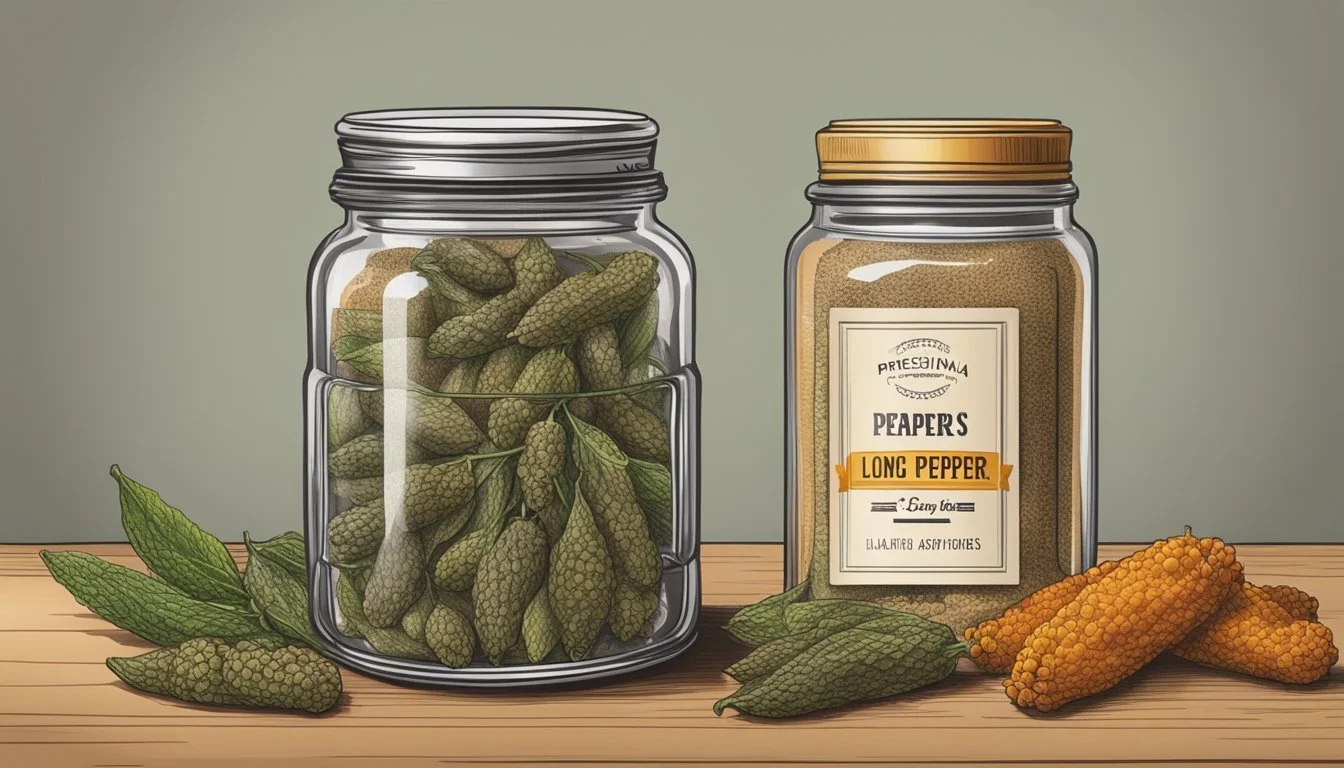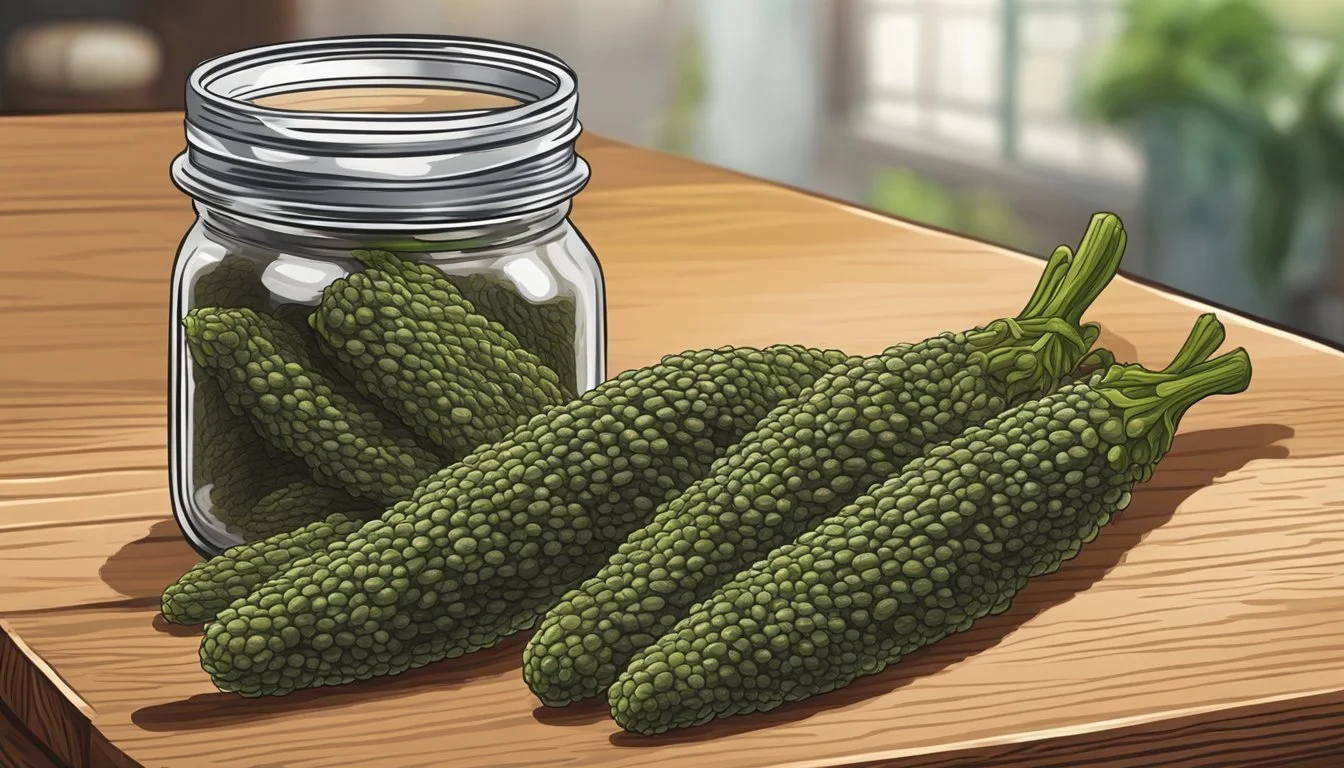Does Long Pepper Go Bad?
Storage Tips and Shelf Life
Long pepper, a close relative of black pepper, is a spice known for its unique, elongated appearance and complex flavor profile. Derived from the plant Piper longum, this spice has been used for centuries to enhance various culinary dishes. Although long pepper does not necessarily spoil, its quality and flavor can diminish over time if not stored properly.
The shelf life of long pepper largely depends on how it is stored. Whole long pepper can maintain its quality for several years when kept in a cool, dry, and dark place, away from exposure to heat and moisture. Proper storage is crucial in slowing down the spice's natural degradation process and preserving its aromatic properties.
For those who enjoy using this exotic spice in their cooking, investing in proper storage solutions such as airtight containers can be beneficial. Grinding long pepper as needed rather than purchasing it pre-ground can also help in retaining its potent flavor for a longer period. By following these simple storage tips, one can ensure that their supply of long pepper remains fresh and flavorful.
Understanding Long Pepper
Long pepper is a unique spice with a rich history, diverse culinary uses, and several health benefits. It offers a distinct flavor profile and is used in various cuisines around the world.
Botanical Profile
Long pepper, known scientifically as Piper longum, is a fruit of a flowering vine native to India and Southeast Asia. It resembles small catkins and contains seeds similar to black pepper. Unlike Piper nigrum (black pepper), it has a more complex taste, often described as a combination of ginger, cardamom, nutmeg, and cinnamon. The plant thrives in tropical climates and is harvested when the spikes are fully mature but still green.
Culinary Uses
Long pepper is prized in Indian, Thai, Cambodian, and Indonesian cuisines for its unique flavor. It's used to season meats, soups, and stews, often ground or crushed before use. In Indian cuisine, it's a key ingredient in spice blends like garam masala. Chefs favor it for its ability to add depth and warmth. It can be used as a substitute for black pepper in recipes when a more intense and aromatic flavor is desired.
Health Benefits
Long pepper offers several health benefits, particularly for digestion and weight management. It's known to stimulate appetite and aid in the digestive process due to its piperine content. Piperine also enhances nutrient absorption, making other foods more nutritious. It's often used in Ayurvedic medicine to treat various ailments, including respiratory issues and inflammation. Current studies suggest it may assist in weight loss by boosting metabolism. Long pepper is also a source of essential nutrients like vitamin C and calcium.
Factors Affecting Long Pepper Quality
Several elements contribute to the quality of long pepper, influencing its flavor, taste, and overall usability.
Freshness and Potency
The freshness of long pepper significantly affects its potency. Freshly harvested long pepper maintains its strong, spicy flavor much better than older pepper. Over time, the essential oils that give the spice its characteristic heat can degrade, reducing potency.
Storage conditions play a pivotal role in maintaining freshness. Cool, dark, and dry environments are ideal for preserving the quality and potency of long pepper. Airtight containers can also help keep the essential oils intact, which preserves its heat and overall flavor profile.
Color and Aroma
Color and aroma are primary indicators of long pepper’s quality. Fresh long pepper should exhibit a dark, rich hue. Any signs of dullness or fading can suggest a loss of flavor and freshness. The aroma also indicates quality.
An intense, robust scent is characteristic of fresh long pepper. If the spice emits a weak smell or an off odor, it might be past its prime. Storing long pepper properly can help maintain color and aromatic integrity, ensuring the spice remains effective in culinary applications.
Texture and Firmness
The texture and firmness of long pepper also denote its quality. High-quality long pepper should be firm and slightly rough to the touch. Loss of firmness can indicate that the spice has become too dry or is starting to degrade.
Proper storage affects texture significantly. Keeping long pepper in a humidity-controlled environment helps maintain the right level of moisture, preserving its firm texture. If the spice becomes too soft or brittle, it is likely losing its desired qualities and may not provide the same culinary benefits.
Shelf Life of Long Pepper
Long pepper, unlike regular black pepper, has unique characteristics that affect its shelf life. The longevity depends on whether it is in whole or ground form and how it is stored.
Whole Peppercorns versus Ground
Whole long peppercorns generally last longer than ground long pepper. When stored properly in a cool, dry place and kept in an airtight container, whole peppercorns can retain their potency for about 5-6 years. This is primarily because the whole form protects the essential oils and flavors from degrading quickly.
Ground long pepper, on the other hand, has a shorter shelf life of about 2-3 years. Grinding exposes the spice to air and moisture, which accelerates the loss of flavor and aroma. For the best results, it is recommended to grind long pepper as needed rather than in bulk.
Expiration and Best Before Dates
Most commercial packages of long pepper will come with an expiration or "best before" date. These dates are guidelines for peak quality, not safety. Generally, long pepper remains safe to consume even after these dates, although it might lose some of its flavor and potency.
To maximize shelf life, it is important to store long pepper away from direct sunlight and moisture. Airtight containers or sealed bags help in preserving its quality over time. If there is any change in smell, color, or the presence of mold, these could be indications that the spice has degraded and may no longer be suitable for use.
Storage Practices for Longevity
Proper storage of long pepper is essential to extend its shelf life and maintain its potency. Key practices include controlling light exposure, container choice, and environment conditions.
Proper Storage Conditions
Keeping long pepper in a cool, dark place prolongs its usable life. Direct sunlight can degrade the pepper's quality, so a pantry or cupboard is preferable.
Avoid areas with fluctuating temperatures or high humidity, as these can cause mold growth and flavor loss. Consistent low humidity is critical to preserving the spice's integrity.
Refrigeration and freezing are unnecessary and may introduce moisture if the pepper isn't properly sealed.
Containers and Packaging
Airtight containers are vital for maintaining the freshness of long pepper. Glass jars with tight seals, metal tins, or ceramic containers are excellent choices.
For more flexibility, resealable plastic bags or ziplock bags can be used, ensuring that all air is expelled before sealing. This minimizes oxidation and potential contamination.
Avoid storing in original paper or cardboard packaging over extended periods, as these materials are not moisture-resistant.
Environment and Temperature
Storing long pepper at a stable temperature is ideal. Room temperature, around 68-72°F (20-22°C), is sufficient to maintain its quality.
Avoid placement near heat sources like stoves or ovens, which can cause degradation.
Humidity control is equally crucial. Keeping the spice in a dry place prevents clumping or mold formation. Using desiccants in storage containers can help control moisture.
In summary, maintaining the right environment and container choice are key to preserving the quality of long pepper for extended periods.
Identifying Spoiled Long Pepper
Recognizing when long pepper has spoiled is crucial for safety and flavor. By identifying signs of spoilage, preventing contamination, and knowing when to discard, you can ensure your pepper remains fresh and safe.
Signs of Spoilage
Visual Indicators:
Wrinkles: Fresh long peppers are firm and have smooth skin. Wrinkly and shriveled skin indicates aging.
Mold: Presence of white, brown, or green mold on any part of the pepper is a clear sign it has gone bad.
Spots: Brown or black spots, especially if spreading, suggest spoilage.
Texture:
Sliminess: Fresh long peppers should be dry. If they feel wet or slimy, they are deteriorating.
Softness: A soft or mushy texture rather than the usual firmness signals the pepper is no longer fresh.
Smell:
Foul Odor: A strong, unpleasant smell instead of the usual peppery aroma indicates spoilage.
Preventing Contamination
Storage:
Dry Environment: Store long pepper in a cool, dry place to minimize moisture which promotes mold growth.
Airtight Containers: Use airtight containers to protect against pests and reduce exposure to air, which can speed up spoilage.
Clean Spaces: Ensure storage areas are clean to prevent contamination from bacteria or mold.
Handling:
Clean Hands/Utensils: Always handle with clean hands and use clean utensils to avoid introducing contaminants.
Separate Storage: Keep long pepper away from other spoiling vegetables or fruits to avoid cross-contamination.
Inspection:
Regular Checks: Regularly inspect stored peppers for signs of deterioration to catch spoilage early and prevent it from spreading to other items.
When to Discard
Visual and Texture Changes:
Excessive Wrinkling: When wrinkles cover most of the surface, it's best to discard.
Mold Presence: Any sign of mold means the pepper should be immediately thrown out.
Skin Breaks: Cracked or damaged skin can harbor bacteria, making the pepper unsafe.
Smell and Taste:
Rancid Smell: If the pepper emits a sour or foul smell, it is unsafe to use.
Off Taste: A bad taste indicates the pepper has gone bad and should not be consumed.
Regularly monitoring and correctly storing long pepper helps maintain its quality and ensures it remains safe for consumption.
Best Practices When Using Long Pepper
To achieve the best culinary results with long pepper, it's essential to understand how to store, prepare, and utilize this spice.
Maximizing Flavor in Cooking
Long pepper has a unique flavor profile that can be enhanced through careful preparation. Toasting long pepper in a dry skillet before use can bring out its complexity. This step should be done on medium heat for about 1-2 minutes until the pepper becomes fragrant.
When adding long pepper to recipes, it can be used similarly to ground black pepper, though it has a more intense heat and slightly sweeter notes. Incorporate it into dishes like stews, soups, and sauces where the prolonged cooking time allows the flavors to meld. For a lighter touch, sprinkling freshly ground long pepper over salads or pasta can add a distinctive finish.
Storing long pepper correctly is important for maintaining its flavor. It should be kept in an airtight container, placed in a cool, dark place such as a spice rack. Exposure to light, heat, and moisture can quickly degrade its quality.
Pepper Mill Versus Pre-Ground
Using a pepper mill for long pepper can significantly enhance your cooking experience compared to pre-ground options. Freshly ground pepper retains more of its essential oils, providing a more robust flavor. A sturdy pepper mill, specifically designed to handle the larger and tougher long pepper, is recommended.
Pre-ground pepper, while convenient, tends to lose its potency over time due to exposure to air and light. Additionally, pre-ground long pepper can sometimes contain fillers, reducing its purity.
For those who bake, incorporating freshly ground long pepper into bread and pastry recipes can impart a unique aroma and taste. It can be particularly effective in savory bakes, adding an unexpected twist to traditional recipes.
Choosing between a pepper mill and pre-ground pepper depends on the desired flavor intensity and the type of dish being prepared. For maximum freshness and flavor, grinding long pepper just before use is the optimal choice.







